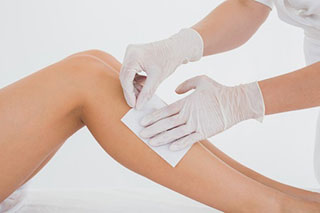Studio 8’s guide to Waxing
by Lisa Young – Salon Director
 Traditional waxing has been around for decades and despite the introduction of alternative hair removal techniques such as IPL and epilation devices waxing is still as popular as ever.
Traditional waxing has been around for decades and despite the introduction of alternative hair removal techniques such as IPL and epilation devices waxing is still as popular as ever.
In recent years, new advanced waxing systems from France and Australia such as Perron Rigot, Lycon and Adam and Eve have risen in popularity.
These new quality waxes are made from advanced resins and aromatherapy oils offering virtually pain free waxing with less trauma to the skin.
Combined with new advanced techniques, Hollywood and Brazilian waxing (despite the sensitive and delicate area) is virtually pain free waxing offering clients confidence, low maintenance and less downtime.
Whether you are a first-time or regular waxer, by following our guide you can achieve super smooth legs and bikini confidence wax not only for the holiday season but all year round.
Go Pro for your waxing treatments
Waxing at home can be a false economy. Home use wax kits are expensive, messy and aren’t as effective as professional products. Unless you are experienced at waxing you risk bruising or even getting burnt. A skilled waxing therapist knows how to stretch the skin therefore aiding comfort and avoiding the risk of bruising.
Choose a skilled and experienced waxing therapist for your treatment. Remember that intimate waxing techniques such as Brazilian and Hollywood require more advanced training. The treatment should not be intimidating so a therapist who has been trained properly will make you feel relaxed and at ease by explaining and guiding you through the process as well as leaving you with a perfect finish.
Ask your friends for recommendations or check salon’s reviews to see what other Clients are saying. A good tip is to look for salons that use a quality brand as these brands insist on training therapists before they are allowed to stock their products and insist on a specific waxing technique to ensure that their products are used in the correct way to provide amazing results.
No shave zone !
Resist the temptation to shave between visits and you will remain hair-free for longer, which ensures a smoother more even finish each treatment. It normally takes a couple of waxes to even out the growth after shaving, so schedule waxing every three to four weeks apart to get into a good cycle. Keep at it and you will find that waxing makes the hair grow back softer, less bristly and more gradually between treatments! Some waxes such as Lycon can remove hair as short as 1 mm, so you don’t need to wait as long to get started with your waxing !
Be honest with your therapist
A good therapist will undertake a thorough consultation each visit but you also need to be honest with the therapist. Make sure you tell the therapist about:
- Recent sun exposure or use of sunbeds.
- If you are on a diet.
- Illness or operations/anaesthetic.
- Medication or prescribed problem skin products.
- New skincare products especially those under the guidance of a dermatologist.
- Stress levels.
This ensures that you are suitable to be waxed each treatment so you do not suffer sensitivity or adverse reactions. Even a low fat diet or a bit of stress can have an effect on how your skin behaves when waxed.
Cleanliness
When you arrive for your waxing treatment, the room, equipment and wax pot should always be spotless. Wooden spatulas should never be “double dipped” (the same stick dipped back into the wax again and again). Many salons now use metal spatulas as they are non-porous and do not harbour germs. For correct application, the wax should flow off the spatula without contact with the skin.
Therapists should wear gloves, especially for intimate waxing. The golden rule is; new area – new gloves.
Prepare
To get the best results always prepare before waxing. Regular exfoliation with a body brush or exfoliation product between treatments, especially a few days before your appointment, prevents ingrown hairs. Moisturise your skin regularly to keep your skin in tip top condition.
Hot wax vs Warm or Strip Wax
The best waxing salons only use hot wax on sensitive areas such as the bikini, underarms and face as strip wax is not as gentle on these areas.
Hot wax isn’t as hot as it sounds! It’s a thicker wax that is applied to the skin to banana skin thickness. It is often used with a pre waxing oil and always without a cloth strip. It is then allowed to set before removing. It can be applied multiple times to the same area with little or no trauma to the skin. The wax doesn’t stick directly to the skin, instead it shrink wraps around the hairs so that when removed, pulls on the hairs and not on your skin. This means less stickiness, less redness and a better finish. Perfect for intimate waxing!
Warm wax or strip wax is a runny honey consistency wax and used in conjunction with cloth strips. It is normally used for larger areas such as the legs, chests and arms. Therapists apply warm wax using wooden or metal spatulas that glide lightly across the skin, so that the wax is smoothed across the skin. It’s quicker than hot wax as there is no setting or drying time
Follow the Aftercare Advice
Always follow the aftercare advice to avoid infections and irritation. Remember that your hair follicles will be still open so you are more at risk of infection, sensitivity or redness. Typical aftercare includes:
- No swimming, hot baths/showers, saunas or hot tubs for 24 hrs after waxing.
- No sunbathing for 24-48 hours pre and post waxing.
- Avoid highly perfumed products on the waxed area for 24 hours after waxing.
- There are some products that reduce the risk of ingrown hairs such as Lycon’s Ingrown X-it, but regular body brushing or exfoliation is a great alternative
Ingrown hairs
Ingrown hairs appear as red lumps under the skin and are caused by:
- Hairs that were broken off when waxed.
- As a result of poor aftercare.
- Garments that rub or cause friction, typically the knicker line.
Regular gentle exfoliation or body brushing as part of your skincare routine not only benefits your skin overall but reduces the risk of ingrown hairs. Invest in a good exfoliating glove, body brush or body scrub. If you get any ingrown hairs, gently exfoliate the area over a few days to remove dead skin cells to help encourage the hair to break through.
Quote of the Day
” Hair free is care free “
Anon
